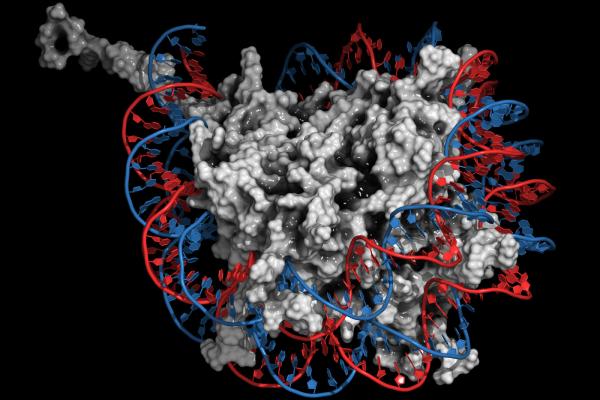How an essential class of proteins can access blocked genes

Research shows how ‘pioneer factors’ function as master regulators of genes from yeast to humans
Genetic information contained within DNA has to be read by specific proteins that enable the process of gene activation to begin – but in many cases, these proteins can’t access their targets because DNA strands are bundled up to control what genes are used in the wide range of different cell types.
New research led by scientists at The Ohio State University shows how one of these proteins, known as a transcription factor, functions as a special “pioneer factor” by managing to bind to a blocked segment of DNA to begin the process of opening up and activating a gene.
The research was conducted in budding yeast, a single-cell organism, but the transcription factor studied, called Cbf1, is among a family of proteins with a long evolutionary history that have a basic helix-loop-helix configuration – a structural feature similar to about 100 transcription factors known to exist in humans.
“In humans, mutations in this class of transcription factors play central roles in cancer,” said Michael Poirier, lead corresponding author of the study and professor and chair of the Department of Physics at The Ohio State University.
“This work tells us one of the main ways genes are activated,” Poirier said. “We’re trying to understand, at a fundamental level, how cells work with the idea that this ultimately provides the information one needs to understand disease and develop therapies.”
Benjamin Donovan, a biophysics graduate student in Poirier’s lab, is first author of the study. Song Tan and Lu Bai, professors in Penn State University’s Department of Biochemistry and Molecular Biology, were co-corresponding authors of the paper, which was recently published in Molecular Cell.
In plants, animals and other organisms whose cells have a nucleus, sections of DNA spool around a collection of histone proteins to form nucleosomes, similarly to how a watering hose might be organized in a backyard. Once locked into a nucleosome spool, portions of those DNA segments can’t be accessed by most transcription factors.
But a special class of these binding proteins found in humans and recently discovered in plants, called pioneer factors, “can access sites that are not accessible,” Poirier said. “How they do that has been a complete mystery.”
In a previous paper, Poirier, Bai, Donovan and collaborators showed that the Cbf1 transcription factor could bind to its target site despite that site being embedded within a nucleosome, essentially revealing Cbf1 is equivalent to a pioneer factor. The researchers also observed with single molecule microscopy that this capability was related to the protein’s unexpected tendency to remain present within the spool for an unusually long time. Most transcription factors that manage to bind within nucleosomes aren’t able to maintain the connection for very long – they disengage quickly through a process called dissociation.
“We showed that this long retention of Cbf1 generated very efficient occupancy within a nucleosome even though the binding site is largely blocked so it had to wait for the nucleosome to unwrap to then bind. But that paper gave no insight into how it worked: How does pioneer factor Cbf1 stick around for so long? And why?” Poirier said.
In this new study, the team tested their theory that Cbf1 sticks around by making use of the histone proteins around which nucleosomes form.
Using single molecule measurements, Donovan revealed that the helix-loop-helix structure of Cbf1, which resembles the structure of another well-studied yeast transcription factor, could play a role in its special capabilities. A series of experiments confirmed this structure was essential to the nucleosome binding success.
Electron microscopy from the Tan lab showed Cbf1’s positioning indicated the helix-loop-helix region of its structure interacts with histones, and the scientists confirmed the attachment location by mutating histone-interacting regions and observing a weakening of the bond.
These extra histone interactions facilitated Cbf1’s ability to function as a pioneer factor by retaining, for typically a minute, Cbf1 at its target DNA site within the partially unspooled nucleosome. The researchers call this phenomenon a dissociation rate compensation mechanism.
Studies from the Bai lab in live budding yeast showed nucleosomes were displaced by Cbf1, and that its histone interactions resulted in expected functional outcomes.
Once pioneer factors bind to a nucleosome, other proteins and enzymes enter the picture to move along the process leading to gene expression and protein building.
“We’ve explained molecularly and mechanistically how a pioneer factor can function and shown where the dissociation rate compensation mechanism comes from: in part, from histone interactions,” Poirier said. “If they don’t bind, none of this can get started – they are key to launching gene expression.”
This work was supported by the National Institutes of Health, the National Science Foundation and the Estonian Research Council.
Additional co-authors include Hengye Chen of Penn State, Priit Eek of Tallinn University of Technology, and Zhiyuan Meng and Caroline Jipa of Ohio State.
How an essential class of proteins can access blocked genes (osu.edu)
Getty Images
Read More: Nature
